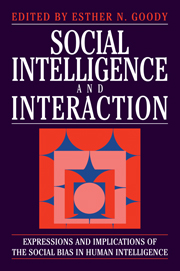 Social Intelligence and Interaction
Social Intelligence and Interaction Book contents
- Frontmatter
- Contents
- List of contributors
- Conventions used in transcripts
- Preface
- Introduction: some implications of a social origin of intelligence
- Part I Primary processes
- Part II The interactive negotiation of meaning in conversation
- 4 On projection
- 5 Interaction sequences and anticipatory interactive planning
- 6 Where does foresight end and hindsight begin?
- Part III Genres as tools that shape interation
- Part IV Expressions of a social bias in intelligence
- Consolidated bibliography
- Index
6 - Where does foresight end and hindsight begin?
Published online by Cambridge University Press: 09 January 2010
- Frontmatter
- Contents
- List of contributors
- Conventions used in transcripts
- Preface
- Introduction: some implications of a social origin of intelligence
- Part I Primary processes
- Part II The interactive negotiation of meaning in conversation
- 4 On projection
- 5 Interaction sequences and anticipatory interactive planning
- 6 Where does foresight end and hindsight begin?
- Part III Genres as tools that shape interation
- Part IV Expressions of a social bias in intelligence
- Consolidated bibliography
- Index
Summary
There is much to be said in favour of the idea that anticipation and the preemption and deception which it permits play an important role in the social life of both humans and a number of other primates. This idea has been developed anew, particularly for the human case, in a number of different disciplines for a variety of different reasons. Goody (this volume), points to a number of instances, and the list could be extened almost ad nauseam. It ranges from computer scientists proposing plan-construction algorithms and user-modelling procedures for natural language front-ends, to economists speculating on the actions of economic agents planning their moves in the market-place with respect to the actions of others. The scope and explanatory range of this idea in any of these fields has always been questionable. In economics, for example, the very different effects of ignorance, habit and culture on individual choice have often been far greater than those of individual ratiocination. Nevertheless, any area of human activity which involves actual or potential interaction with other humans (and that might mean all of human life) can be seen to have characteristics which reveal an anticipation of how others will view and respond to one's actions.
If we restrict our consideration of anticipation to human conversations, many writers have proposed that they have a measure of foreseeability built in. For example, conversation analysts have argued that there are clear expectations as to what kinds of turn may follow other turns, as in adjacency pairs, and participants must mark utterances, which do not conform to the expected trajectory of the conversation in some way so that their marked or dispreferred status is signalled (see, for example, the discussion of their work in Levinson (1983), or the papers in Atkinson and Heritage (1986)).
- Type
- Chapter
- Information
- Social Intelligence and InteractionExpressions and implications of the social bias in human intelligence, pp. 139 - 150Publisher: Cambridge University PressPrint publication year: 1995
- 23
- Cited by


